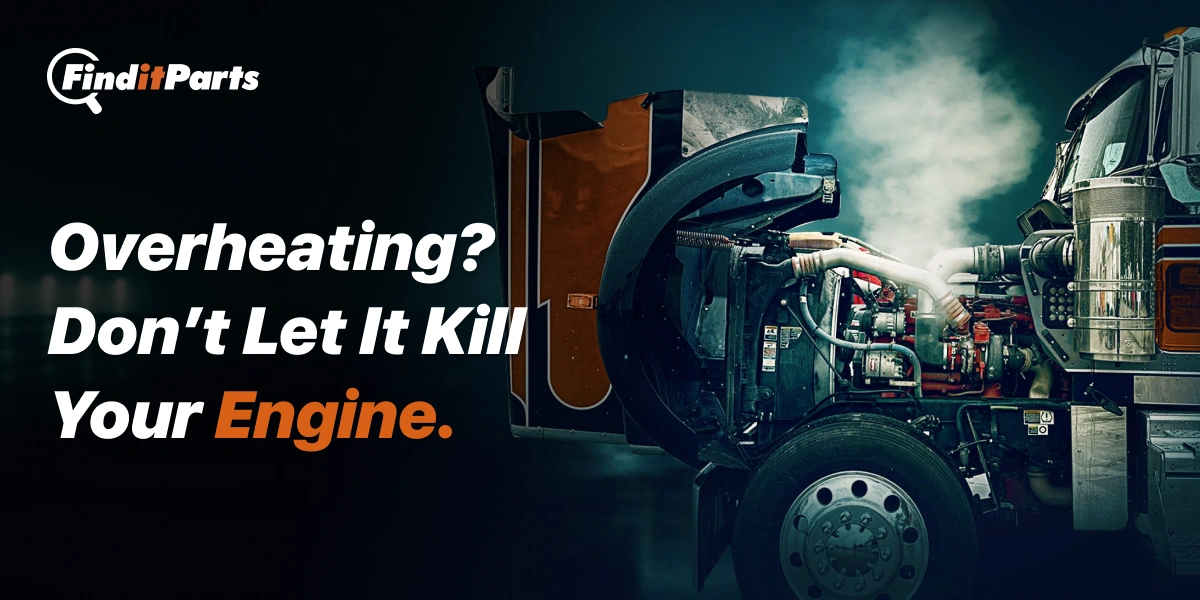Need help? We're here!
(888) 312-8812 Login SignupSigns Your Semi Needs a New Radiator (And How to Choose One)
June 23, 2025

June 23, 2025

Your semi-truck’s radiator works hard to keep the engine cool under intense loads and long hauls. But like most heavy-duty components, it won’t last forever. Ignoring radiator issues can lead to overheating, engine damage, or even a breakdown on the side of the road.
Whether you’re a fleet owner, driver, or diesel tech, this guide will help you identify the signs of radiator failure—and give you the know-how to choose the right replacement when the time comes.
Overheating is the number one red flag. If your coolant levels are normal but the temperature gauge keeps spiking, the radiator could be clogged or corroded, reducing its ability to dissipate heat. (Thermostats are designed to fail in the open positions but in some cases can fail closed and cause over heating issues)
Green, orange, or pink puddles under your truck? That’s coolant, and it’s likely escaping from a cracked radiator tank, worn-out hose connection, or broken seam. Leaks don’t fix themselves—this is a sign it’s time to inspect or replace the radiator.
Radiators should circulate clean, brightly colored coolant. If it looks rusty or thick, it could indicate corrosion inside the radiator, often caused by old coolant or internal metal breakdown.
(discoloring and or clogging can be the sign of a much larger issue, cylinder head gasket and engine or transmission oil coolers can fail and push oil into the coolant system. Most times the radiator will be the first place you see evidence of these issues.)
(You should use the coolant coolant that the system calls for Extended Life Coolant (ELC) is red and used in newer trucks. “Standard” coolant or Inorganic additive coolant (IAT) is green and used in older trucks)
(the nitrite levels should be checked every service and maintained with supplemental coolant additives (SCA) and the correct “charged” coolant filter should be used. Incorrect nitrite levels can cause pitting and corrosion.)
If you’re constantly adding coolant but can’t find an obvious leak, you might have a slow internal leak from the radiator or related components. It’s a sneaky sign that something isn’t working properly.
Hissing sounds under the hood or visible steam can mean coolant is boiling or leaking onto hot engine parts. That’s a safety issue—and your radiator may be the root cause.
(an out of solace sweet smell is also a sign that there is a coolant leak)
Not all radiators are created equal. Choosing the right one depends on your truck’s specs, the conditions you drive in, and your budget. Here’s what to look for:
Always start by selecting a radiator designed to fit your truck’s year, make, and model. Poor fitment can cause installation issues and reduce cooling efficiency.
Tip: Use FinditParts’ easy part search by VIN or part number to ensure a perfect match.
Most heavy-duty truck radiators are made from:
Aluminum – Lightweight and corrosion-resistant, often paired with plastic tanks.
Copper/Brass – Known for excellent thermal conductivity but heavier.
All-metal options – Great for durability in harsh environments.
Each material has tradeoffs in cost, weight, and longevity. Choose based on your application.
If you haul heavy loads, operate in extreme heat, or run long distances daily, opt for a radiator with increased cooling capacity. More rows or thicker cores can make a big difference in engine temp control.
OEM Radiators: Built to original specs; often more expensive but offer guaranteed fit.
Aftermarket Radiators: Often more affordable, with options for enhanced performance or durability. Just make sure you buy from a trusted source.
Look for radiators that come with a solid warranty—especially if you're investing in a high-performance or heavy-duty model. Warranties help protect your investment.
When replacing your radiator, it’s smart to inspect or replace related components that affect the cooling system:
A full-system check can prevent future problems and keep your cooling system running efficiently.
Keep Your Cool with FinditParts
Whether you're driving a Peterbilt, Kenworth, Freightliner, International, Mack, or Volvo, FinditParts has a wide selection of semi-truck radiators and cooling system components. From OEM replacements to reliable aftermarket parts, we make it easy to find what fits—fast.
With millions of parts in stock and an intuitive search platform, we’re your trusted partner in keeping your rig running strong.
Browse radiators and cooling system parts at FinditParts.com
Pro Tip: Maintain Your Radiator
To extend radiator life, follow these tips:
Flush your coolant system every 2 years (or as recommended).
Use the correct coolant type.
Check hoses and clamps regularly.
Don’t ignore minor leaks—they get worse fast.
Test the nitrite levels and correct issues early